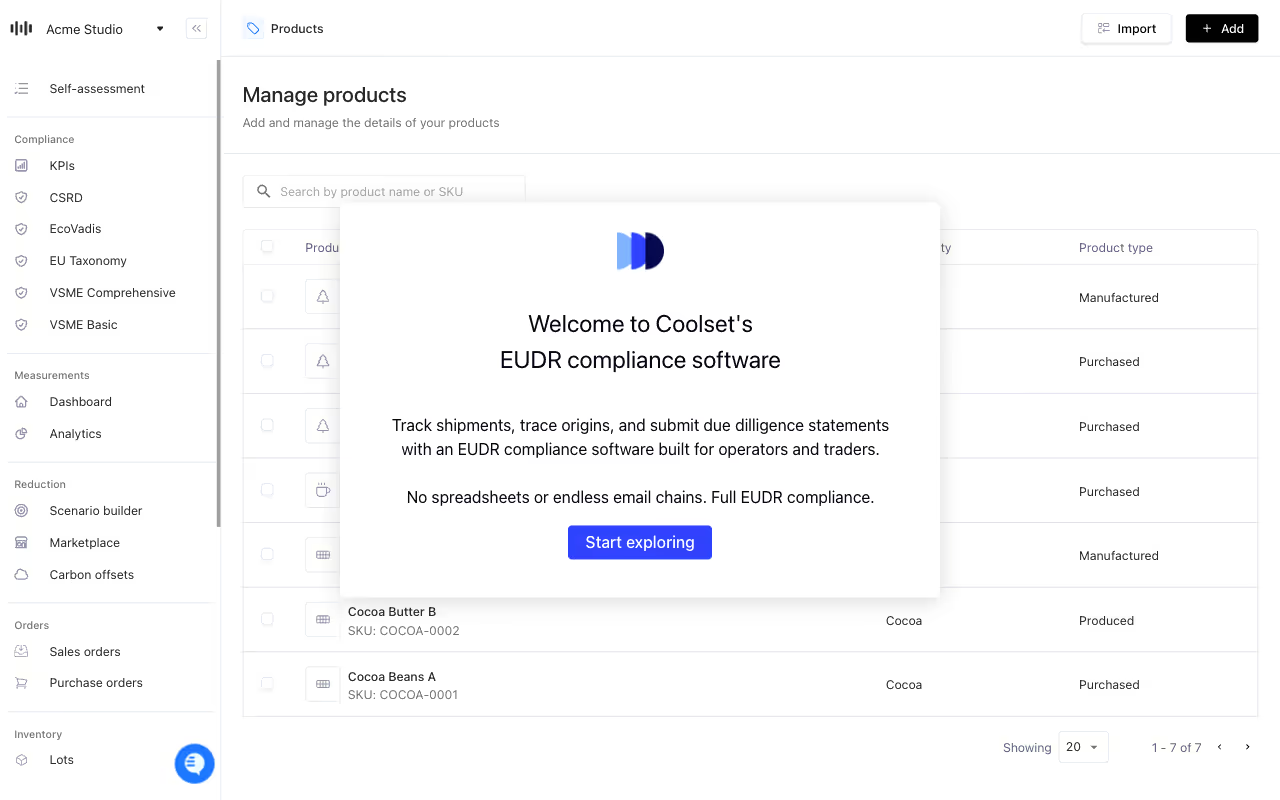Disclaimer: New EUDR developments - December 2025
In November 2025, the European Parliament and Council backed key changes to the EU Deforestation Regulation (EUDR), including a 12‑month enforcement delay and simplified obligations based on company size and supply chain role.
Key changes proposed:
These updates are not yet legally binding. A final text will be confirmed through trilogue negotiations and formal publication in the EU’s Official Journal. Until then, the current EUDR regulation and deadlines remain in force.
We continue to monitor developments and will update all guidance as the final law is adopted.
Der Omnibus-Vorschlag soll die ESRS E4-Berichtspflichten überarbeiten, um die Komplexität zu reduzieren und gleichzeitig die Ziele des europäischen Grünen Deals zur Biodiversität zu wahren. EFRAG, das technische Gremium für die Aktualisierung der EU-Nachhaltigkeitsberichtsstandards, wird seine endgültigen Empfehlungen zu ESRS E4 bis zum 31. Oktober 2025 an die Europäische Kommission übermitteln, nach einer strukturierten öffentlichen Konsultation und einem Stakeholder-Eingabeprozess. Die Konsultationsphase endete am 6. Mai 2025, mit Entwurfsüberarbeitungen bis Juli und weiteren öffentlichen Feedbackrunden im August und September. Obwohl die Überarbeitungen noch finalisiert werden, hat EFRAG einen Fokus auf die Klärung von Wesentlichkeitsbewertungen, die Vereinfachung von Wirkungsberichten und die Verbesserung der Konsistenz mit globalen Berichtsrahmen angekündigt. Für die neuesten Entwicklungen zu ESRS und CSRD-Compliance-Leitfäden besuchen Sie die offizielle Website von EFRAG.
Die Einführung der Corporate Sustainability Reporting Directive (CSRD) markiert einen wichtigen Meilenstein zur Verbesserung der Qualität von Unternehmensnachhaltigkeitsinformationen in Europa. Obwohl der EU-Omnibus-Vorschlag den Umfang vieler Unternehmen, die über CSRD berichten, ändern wird, planen 90 %, fortzufahren.
Wenn Ihr Unternehmen plant, über CSRD zu berichten, sei es direkt oder durch Anforderungen der Wertschöpfungskette, sollte das Verständnis der European Sustainability Reporting Standards (ESRS) – einschließlich ESRS E4 über Biodiversität und Ökosysteme – oberste Priorität haben. Neben der regulatorischen Compliance ist es ein mächtiges Werkzeug, um eine nachhaltigere Zukunft für Ihr Unternehmen und den Planeten zu gestalten.
Aber was genau ist ESRS E4 und warum ist es so wichtig? Was sind seine Kernanforderungen? Und wie können Sie ESRS E4 effektiv umsetzen? Lesen Sie weiter, um alles zu erfahren, was Sie wissen müssen, um diesen Standard mit Zuversicht zu verwalten.
ESRS E4 konzentriert sich auf Biodiversität und Ökosysteme und hebt ihre wesentliche Rolle in der Nachhaltigkeit hervor. Biodiversität unterstützt kritische Ökosystemdienstleistungen wie Bestäubung, Wasserreinigung und Klimaregulierung, steht jedoch unter starkem Druck durch Abholzung, Lebensraumzerstörung, Übernutzung und Klimawandel. Diese Belastungen gefährden sowohl die ökologische Gesundheit als auch die wirtschaftliche Stabilität.
ESRS E4 verlangt von Unternehmen, über ihre Auswirkungen und Abhängigkeiten von Biodiversität und Ökosystemen zu berichten, einschließlich Landnutzung, Lebensraumrestaurierung und Artenschutz. Dies gewährleistet die Ausrichtung auf globale Biodiversitätsziele und erhöht die Transparenz und Verantwortlichkeit.
Der Schutz von Ökosystemen ist ebenfalls entscheidend in ESRS E4, da gesunde Ökosysteme die Biodiversität erhalten und die Widerstandsfähigkeit gegen Umwelt- und Wirtschaftsrisiken untermauern. Durch die Behandlung von Auswirkungen und Chancen durch ESRS E4 können Unternehmen nachhaltige Praktiken übernehmen, Risiken mindern und globale ökologische Ziele unterstützen.
Um die allgemeinen Offenlegungen von ESRS 2 mit ESRS E4 für Biodiversität und Ökosysteme in Einklang zu bringen, sollten sich Unternehmen auf die folgenden Schlüsselbereiche von ESRS 2 konzentrieren:
Dieser strukturierte Ansatz hilft Unternehmen, Biodiversität in Governance, Strategie und Risikomanagement zu integrieren und Stakeholdern einen umfassenden Überblick über ihre Umweltverpflichtungen zu bieten.

Unter ESRS E4-1 müssen Unternehmen offenlegen, wie Biodiversitäts- und Ökosystem-bezogene Auswirkungen, Risiken und Chancen ihre Strategie und ihr Geschäftsmodell prägen. Diese Offenlegung demonstriert die Widerstandsfähigkeit ihres Ansatzes und seine Ausrichtung auf lokale, nationale und globale Biodiversitätsziele.
Wichtige Elemente zur Offenlegung umfassen:
Unternehmen können Offenlegungen mit ESRS 2 SBM-3 verknüpfen, wenn zutreffend, und werden ermutigt, ihre Pläne mit Rahmenwerken wie dem Kunming-Montreal Global Biodiversity Framework und der EU-Biodiversitätsstrategie für 2030 in Einklang zu bringen. Dieser Ansatz bietet Transparenz darüber, wie Biodiversitätsüberlegungen in die langfristige Geschäftsplanung integriert werden.
Unter SBM-3 müssen Unternehmen offenlegen, wie ihre Operationen biodiversitätssensible Gebiete beeinflussen. Dies umfasst die Bereitstellung einer Liste signifikanter Standorte unter operativer Kontrolle, einschließlich:
Unternehmen müssen auch offenlegen, ob ihre Aktivitäten zur Landdegradation, Wüstenbildung oder Bodenversiegelung beitragen und ob sie Operationen haben, die bedrohte Arten beeinflussen. Dies ermöglicht es Stakeholdern, Umweltanfälligkeiten und Biodiversitätsrisiken direkt mit dem Geschäftsmodell zu bewerten.
Unter ESRS 2 IRO-1 sind Unternehmen verpflichtet, ihre Prozesse zur Identifizierung und Bewertung von Biodiversitäts- und Ökosystemauswirkungen, -risiken, -abhängigkeiten und -chancen darzulegen. Wichtige Anforderungen umfassen:
Unter ESRS E4-2 müssen Unternehmen Richtlinien zur Verwaltung wesentlicher Auswirkungen, Risiken, Abhängigkeiten und Chancen im Zusammenhang mit Biodiversität und Ökosystemen offenlegen. Dies umfasst die Spezifizierung, wie diese Richtlinien adressieren:
Zusätzlich müssen Unternehmen bestätigen, ob sie spezifische Richtlinien abdecken:
Diese Offenlegungen bieten Transparenz über das Engagement eines Unternehmens für nachhaltiges Ökosystemmanagement und verantwortungsvollen Ressourcennutzung über Operationen und Lieferketten hinweg.
Unter ESRS E4-3 sind Unternehmen verpflichtet, ihre biodiversitäts- und ökosystembezogenen Maßnahmen und die zugewiesenen Ressourcen zur Umsetzung offenzulegen. Diese Anforderung bietet Einblick, wie die Maßnahmen des Unternehmens die Ziele und Vorgaben der Biodiversitäts- und Ökosystempolitik unterstützen.
Wichtige Elemente zur Offenlegung umfassen:
{{custom-cta}}
Unter ESRS E4-4 müssen Unternehmen die von ihnen gesetzten biodiversitäts- und ökosystembezogenen Ziele offenlegen. Diese Anforderung hilft Stakeholdern zu verstehen, wie diese Ziele die Biodiversitätspolitik unterstützen und wesentliche Auswirkungen, Abhängigkeiten, Risiken und Chancen angehen.
Wichtige Elemente der Offenlegung umfassen:
Unter ESRS E4-5 müssen Unternehmen Metriken zur Bewertung ihrer wesentlichen Auswirkungen auf Biodiversitäts- und Ökosystemveränderungen berichten. Dies umfasst:
Diese Metriken bieten Einblick in die Biodiversitätsauswirkungen des Unternehmens und adressieren sowohl direkte operationale Einflüsse als auch Veränderungen der Ökosystemgesundheit.
Unter ESRS E4-6 müssen Unternehmen die erwarteten finanziellen Auswirkungen wesentlicher biodiversitäts- und ökosystembezogener Risiken und Chancen offenlegen. Diese Offenlegung soll Einblick geben, wie diese Umweltfaktoren die finanzielle Position, Leistung und Cashflows eines Unternehmens über kurz-, mittel- und langfristige Horizonte beeinflussen können.
Wichtige Elemente der Offenlegung umfassen:
Diese strukturierte Offenlegung unter E4-6 stellt sicher, dass Stakeholder die potenziellen finanziellen Auswirkungen von biodiversitäts- und ökosystembezogenen Risiken und Chancen verstehen können und die Transparenz im Ansatz des Unternehmens zur ökologischen Nachhaltigkeit verbessert wird.
Um ESRS E4 effektiv umzusetzen, müssen Unternehmen eine doppelte Wesentlichkeitsbewertung durchführen, die sich unter anderem auf biodiversitäts- und ökosystembezogene Themen konzentriert. Dies basiert auf den vier Unterthemen von ESRS E4:
Für jedes Unterthema bewerten Sie, ob Ihr Unternehmen Auswirkungen, Risiken und Chancen (IROs) damit verbunden identifiziert hat. Die Bewertung der Wesentlichkeit dieser IROs hilft festzustellen, ob ESRS E4 als wesentliches Thema qualifiziert ist. Nachfolgend finden Sie einen Überblick über jedes Unterthema, um Ihre Bewertung der IROs in diesen Bereichen zu leiten.
Direkte Einflussfaktoren des Biodiversitätsverlusts: Identifizieren Sie spezifische Geschäftsaktivitäten, die direkt Biodiversitätsverlust verursachen, wie Landnutzungsänderungen, Verschmutzung, Ressourcengewinnung oder Emissionen. Bewerten Sie, wie diese Einflussfaktoren die lokale und globale Biodiversität beeinflussen, insbesondere innerhalb des operativen und Lieferketten-Footprints des Unternehmens.
Auswirkungen auf den Zustand von Arten: Bewerten Sie, wie Unternehmensoperationen die Artenvielfalt und die Gesundheit der Populationen beeinflussen, insbesondere bei gefährdeten oder bedrohten Arten. Dies umfasst die Analyse von Lebensraumstörungen, Mortalitätsrisiken und Artenverdrängung durch Geschäftstätigkeiten.
Auswirkungen auf das Ausmaß und den Zustand von Ökosystemen: Bewerten Sie die Auswirkungen von Operationen auf die Größe, Qualität und Konnektivität von Ökosystemen, wie Wälder, Feuchtgebiete und Meeresumgebungen. Dies umfasst die Verfolgung von Änderungen der Ökosystemintegrität, Degradierung oder Fragmentierung, die durch Geschäftsprozesse verursacht werden.
Auswirkungen und Abhängigkeiten von Ökosystemdienstleistungen: Identifizieren Sie die Ökosystemdienstleistungen, auf die das Unternehmen angewiesen ist, wie Bestäubung, Wasserreinigung und Klimaregulierung, und bewerten Sie, wie seine Aktivitäten diese Dienstleistungen beeinflussen. Das Verständnis von Abhängigkeiten kann dem Unternehmen helfen, Risiken im Zusammenhang mit dem Verlust oder der Degradierung dieser Dienstleistungen zu mindern.
Durch die Fokussierung auf diese Unterthemen können Unternehmen Biodiversitäts- und Ökosystemthemen priorisieren, die für ihre Operationen am wesentlichsten sind, und effektive Strategien zur Verwaltung ihrer Auswirkungen und Abhängigkeiten von natürlichen Ressourcen entwickeln.
.webp)
Um ESRS E4-2 zu erfüllen, sollten Unternehmen Richtlinien entwickeln, die sich auf den Schutz der Biodiversität, die Wiederherstellung von Ökosystemen und die Verhinderung von Degradierung konzentrieren. Diese Richtlinien sollten darlegen, wie das Unternehmen Biodiversitätsauswirkungen, -risiken und -chancen angeht und Verpflichtungen zur Vermeidung, Minimierung und Behebung von Schäden über seine Operationen und die Wertschöpfungskette hinweg enthält.
Um ESRS E4-3 zu erfüllen, sollten Unternehmen einen Aktionsplan entwickeln, der spezifische Schritte und Ressourcenzuweisungen zur Unterstützung der Biodiversitätserhaltung und der Gesundheit von Ökosystemen beschreibt. Dieser Plan sollte gezielte Maßnahmen wie Lebensraumrestaurierung, Artenschutzinitiativen und Maßnahmen zur Minimierung von Biodiversitätsauswirkungen über Operationen hinweg umfassen. Wichtige Maßnahmen können die Umsetzung der Minderungshierarchie umfassen – Vermeidung, Minimierung, Wiederherstellung und, wo notwendig, Ausgleiche – um Biodiversitätsauswirkungen effektiv anzugehen. Der Aktionsplan sollte auch Finanzierung, Zeitrahmen und verantwortliche Teams spezifizieren, um sicherzustellen, dass Ressourcen zur Erreichung messbarer Ergebnisse zugewiesen werden. Die Einbeziehung von lokalem und indigenem Wissen sowie naturbasierte Lösungen kann diese Bemühungen verstärken. Durch die Darlegung klarer Maßnahmen und Ressourcenzusagen bieten Unternehmen Transparenz und demonstrieren ihren proaktiven Ansatz im Biodiversitäts- und Ökosystemmanagement.
Um sich mit ESRS E4-4 in Einklang zu bringen, sollten Unternehmen klare, messbare Ziele für den Biodiversitätserhalt und die Wiederherstellung von Ökosystemen festlegen. Diese Ziele sollten zentrale Themen wie die Reduzierung von Lebensraumstörungen, die Verbesserung der Ökosystemkonnektivität, die Erhöhung geschützter Grünflächen oder die Wiederherstellung degradierter Ökosysteme ansprechen.
Ziele sollten spezifisch und nachverfolgbar sein, mit den Biodiversitätsrichtlinien des Unternehmens verknüpft und mit Rahmenwerken wie dem Kunming-Montreal Global Biodiversity Framework oder der EU-Biodiversitätsstrategie für 2030 abgestimmt sein.
Um ESRS E4-5 zu erfüllen, sollten Unternehmen regelmäßig Biodiversitäts- und Ökosystemmetriken überwachen und berichten, um ihre Auswirkungen zu bewerten und den Fortschritt in Richtung Erhaltungsziele zu verfolgen. Wichtige Metriken könnten Landnutzungsänderungen, Lebensraumrestaurierung, Artentrends und Indikatoren für die Gesundheit von Ökosystemen wie Konnektivität oder Widerstandsfähigkeit umfassen.
Diese Metriken sollten mit den wesentlichen Auswirkungen und Abhängigkeiten des Unternehmens verknüpft sein und biodiversitätssensible Gebiete, bedrohte Arten oder kritische Ökosystemdienstleistungen ansprechen.
Um sich mit ESRS E4-6 in Einklang zu bringen, sollten Unternehmen die finanziellen Auswirkungen biodiversitätsbezogener Risiken und Chancen bewerten und offenlegen, wobei der Fokus darauf liegt, wie sich Änderungen von Ökosystemen oder Erhaltungsbemühungen auf ihre finanzielle Leistung, Position und Cashflows auswirken können.
Dies umfasst die Bewertung von Risiken wie Biodiversitätsverlust, Ressourcenknappheit oder regulatorische Änderungen sowie Chancen wie nachhaltige Ressourcennutzung oder Initiativen zur Wiederherstellung von Ökosystemen. Unternehmen sollten diese finanziellen Auswirkungen, wo möglich, in monetären Begriffen quantifizieren oder qualitative Einblicke bieten, wenn eine Quantifizierung nicht möglich ist.
Offenlegungen sollten die kritischen Annahmen und Zeitrahmen spezifizieren, die in der Analyse berücksichtigt wurden, und einen klaren Überblick darüber bieten, wie Biodiversitätsauswirkungen in die Finanzplanung und Entscheidungsfindung integriert sind.
Um die Einhaltung der ESRS E4-Anforderungen zu verbessern, sollten Organisationen fortschrittliche Tools und Software für eine effiziente Datenerfassung, -analyse und -berichterstattung über Wasser- und Meeresressourcen implementieren.
Durch die Automatisierung von Datenprozessen und die Integration von Analysen können Organisationen fundierte, proaktive Entscheidungen treffen, die Wasserbewirtschaftungspraktiken verbessern und Nachhaltigkeitsziele unterstützen, letztendlich den Berichterstattungsprozess vereinfachen und die Transparenz verbessern. Coolset hilft Nutzern, die CSRD-Compliance zu erreichen, indem es den Berichterstattungsprozess vereinfacht und die Transparenz bei der Berichterstattung von Datenpunkten verbessert. Probieren Sie unsere Software unten aus oder buchen Sie eine Demo hier.
{{product-tour-injectable}}
Our sustainability experts share best practices and break down regulations.






